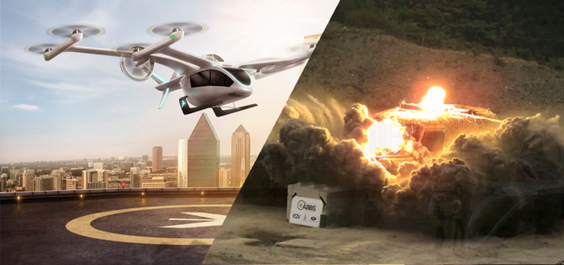
Advanced Blast & Ballistic Systems Limited (ABBS) is a world-leading company that has developed novel, patented solutions to:-
- fully protect the occupants of armoured vehicles hit by mine and IED blasts, and
- to prevent injuries to passengers in eVTOL and other light aircraft that are involved in either controlled or un-controlled emergency landings (crashes.)
The connection between these two different technologies is that in their ultimate form they both use powerful rocket motors to actively counteract the forces acting that will cause the injuries or deaths of the people occupying the vehicles involved.
The Armoured Vehicle Technology
In the case of the armoured vehicles, the rocket motors push down on top of the vehicle to prevent it being blown rapidly into the air, the threat to the occupants being that the rapid acceleration upwards can cause disabling or even fatal spinal crush injuries. Preventing penetration of the cabin volume due to the blast is easily achieved, but the Vehicle Global Acceleration Mitigation system (VGAM™) is the only physically practical way to prevent the ultimate vehicle acceleration threat to the occupants when the vehicle is hit by a large mine or IED.
The VGAM system reacts within 4ms to provide massive downforce to the protected vehicle to keep it on the ground and prevent the potentially fatal spinal compression injuries to the crew. The patented Linear Rocket Motors can be fired selectively, and the effective weight of the vehicle can be increased up to 1,000 tonnes.
This concept has been fully proven by funded UK and US Army vehicle tests and there is strong interest from both the US Army and a major European defence company.
The Passenger eVTOL, Cargo Drone and Light Aircraft Crash Prevention System
In this case the force requiring counteraction is gravity, and we use a combination of parachutes and retrorockets to control the landing speed in essentially every type of un-controlled descent to the ground. In itself this is not novel technology, the picture below shows a Russian tank which may have crew inside being dropped from an aircraft.
However, in order to deal with all the various possible emergency scenarios there are some important differences in how the systems operate in different circumstances, which the ABBS suite of technologies is designed to manage as appropriate.
The first critical element in minimising the potential harm from an emergency landing situation is to find a safe site on which to land immediately any serious problem occurs.
To achieve this ABBS has partnered with a company specialised in self-driving car control systems to jointly develop a Look-Down video/AI system (LD-VAS) to continuously identify emergency landing sites under the aircraft. This system will also provide back-up aircraft GPS location data when the normal GPS signal is not available for any reason. This can and does occur in city environments so the LD-VAS technology is clearly an important safety aid for piloted aircraft and will be essential for autonomous remotely piloted aircraft operations.
The system is equally applicable to eVTOL passenger aircraft, small package delivery drones, and larger cargo drones and in addition to the LD-VAS technology a parachute can be added to control the landing speed, and for heavier aircraft a retrorocket addition will probably be required to minimise landing energy levels.
Whilst a lot of redundancy is being designed into eVTOL and drone aircraft there are several external threats which redundancy may not deal with. Emergency landings may be caused by bird strikes, battery fires, and interference with, or failure of control or GPS navigation systems, so for operation over an urban environment ABBS believes that the ability to instantly identify where to land will be critical for certification to operate.
The extent of R&D that has gone into creating these twin technologies is remarkable, extending back to 2008 when the VGAM concept was first identified with over £8million invested to date. ABBS has created world first innovative solutions that have the potential to save many lives, and there is strong interest from both the military and the eVTOL/drone industries, especially in the USA and Europe.
It’s clever, it’s powerful, and it works.

